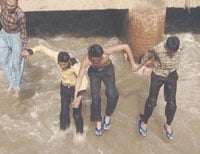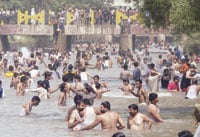The Lahore Canal should be given back to the people as a clean waterway and public park
By Imrana Tiwana
Tense, dense, bursting at the seams, polluted, hazy, uncontrolled, noisy, incredibly nerve wracking, haphazard and delirious... Lahore today is one of the most polluted cities in the country.
The canal is Lahore's unique and most important evironmental asset. The canal road widening project proposed by the government must be stopped immediately. It aims to add two 18 foot lanes on either side each with six foot shoulders. This spells nothing but disaster as the central city area, heavily overburdened, needs to be 'de-congested'. Traffic has to be dispersed and moved out towards the 'emerging Lahore'. But the Canal Road is not the main artery of Lahore, it is just a cross connector.
Alternate routes already exist. As Multan Road is widened and freed of encroachments, there will be a major traffic dispersement. With the Ring Road coming in and seeing the direction of emerging Lahore, the Canal Road will be by-passed altogether. Access to the motorway will be further distributed through widening and clearing of Chowk Yateem Khana exit and Saggian Bridge. G.T Road connects to the Ravi Bridge, and they all join the Ring Road, to take traffic outwards, or inwards. This will take all the current pressure off the Canal Road.
By clearing encroachments from several major roads, which are already underway, critically required dispersion of traffic will take place and the link roads of the city will begin to be used effectively as a network. Crucial to the working of the above is an 'integrated strategy' for road and public transport management.
From Thokar Niaz Beg, to beyond Jallo Park, there are over 300 acres of green belt in the form of public parkland. There are thousands of old trees and shrubs along this length, making a green canopy of shade for all, mostly pedestrians and those on cycle and motorcycle. This area has a unique and special habitat of birds, animals, flora and fauna. The tragedy is that untreated sewage and industrial waste is being dumped into the Canal from over 90 points, reducing it to a glorified dump.
The EPA (Environmental Protection Agency) reports that the main cause of increasing air pollution in Lahore is an increase in vehicular traffic, fast deforestation and rapid urbanisation. How then has the EPA given an NoC for the Canal road widening project? The citizens rejected the EIA (Environmental Impact Assessment) done by Nespak at the 'Public Hearing' held two years ago (the first 'real' public hearing). The EIA was also in violation of the PEPA Act 1977. The EIA itself states that the impacts of road widening will cause irreversible damage to the environment; the only advantage it states is reduction in commuting time. Three years ago, the Chief Justice of the Supreme Court took suo moto notice of this issue and questioned the Punjab Government.
The WWF-Pakistan had conducted its own EIA of the Canal Road widening project, and found that the EIA approved by the Environment Protection Agency, Punjab was fatally flawed. The policy to widen the Canal road was actually against the Environment Policy 2005. "The Policy favours public transport, but in the past decade, no money has been invested in public transport." This project threatens to irreversibly damage the urban fabric and identity of the 'City of Gardens'.
Good governance is 'citizen participatory governance', the citizens of Lahore and the government should partner on creating a world class model of sustainable urbanization with an ecological footprint.
It is imperative that a 'Canal Restoration Project' be started forthwith. That the city of gardens be revitalised through a programme of 'Green Corridor Linkages', creating an accessible green pedestrian network. A 'Green Belt Master plan' must be developed to create a network of green zones and open spaces throughout the city, foreseeing the conservation of whole tracts of land and space as 'Ecologically Valuable Zones' kept free of buildings. Special zoning ordinances, public land purchases, designation of protected zones under 'Nature Conservation' and 'Special Green Zone' legislation should be put into place to ensure the continued existence of these zones.
The Lahore Canal should be given back to the people as a clean waterway and public park; this will act as the 'glue' that brings together people of all classes and ages. Stopping the Canal road widening project is the greatest gift the Punjab Government can give to the teeming millions of Lahore.
The writer, an architect and convener of the Lahore Bachao Tehreek, can be reached at itiwana@yahoo.com
(As published in The News of Sunday, Shehr, 9 August 2009)
No comments:
Post a Comment